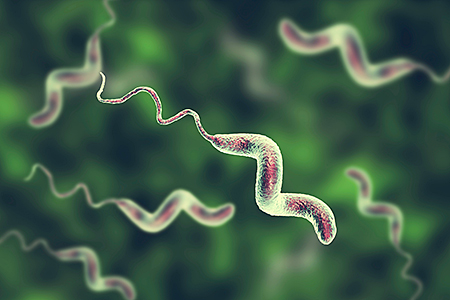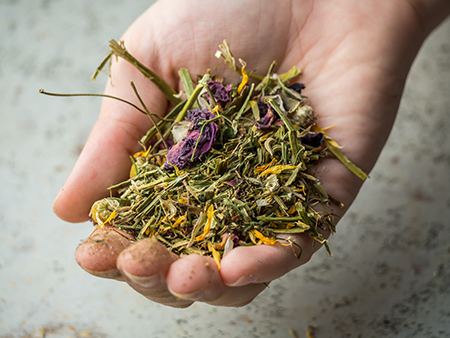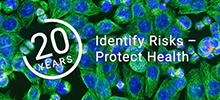Success stories from the BfR
Insights into everyday life at the Federal Institute for Risk Assessment
Whether it's e-cigarettes, tattooing products or antimicrobial resistance - the BfR's spheres of activity are as diverse as life itself. The focus is always on human health.
The BfR anniversary brochure (PDF file,3.74 MB) offers a deeper insight into the work and history of the Institute.

Cooking for science
The identification and characterisation of substance-related risks are part of the BfR’s assessment work. The key question is to what extent we are exposed to potentially harmful substances. In what quantities do we ingest on average not only undesirable, but also desirable substances through our food? Do certain foods vary in their levels of substances depending on the season, cultivation method or region? And what health effects does the type of preparation have on food? Answers are provided by the BfR MEALStudy (meals for exposure assessment and analysis of foods) - Total Diet Study in Germany, launched in 2015. This scientific method is being used to determine the average levels of substances present in already prepared foods. The aim is to obtain representative occurrence data for the German diet and to better identify and quantify food risks. The study team purchased around 60,000 foods during the course of the study, prepared them and analysed them for nearly 300 substances, including mycotoxins, plant protection product residues and nutrients. This makes the BfR MEAL study a highly comprehensive Total Diet Study by global standards.
You can find more on this topic here.
Tracking down germs in food
Bacteria, viruses and other microbes are omnipresent and can also cause food-borne illnesses. The “EHEC crisis” made this clear in 2011. This disease outbreak was the most serious to date in Germany, caused by enterohaemorrhagic Escherichia coli bacteria. More than 4,000 people fell ill and 53 died. At the time, the BfR, in exchange with national and international health authorities, identified imported fenugreek seeds as the cause with a high degree of probability. Since then, software programmed by the BfR has helped to track suspicious foodstuffs and trace outbreaks. Finding the exact product that caused the infections is particularly difficult. The BfR uses whole genome sequencing for this: experts regularly decode and store the genetic make-up (sequence) of bacteria from food samples and other sources. They then compare these with sequences of bacteria isolated from people who have fallen ill. This method has been used to trace around 60 outbreaks of listeriosis in Germany since 2016. These bacteria are particularly hazardous for pregnant women, newborns, immunocompromised people and the elderly. In 2021, the BfR also applied the principle to 45 incidents of infection with Salmonella. Incidentally, the most frequently reported bacterial gastrointestinal disease nationwide is the campylobacteriosis, caused by Campylobacter. To identify infection chains and track down unknown or altered germs, the BfR researches Campylobacter from samples taken from animals, food and the environment. Strategies for the prevention and control of infections are also being developed.
You can find more on this topic here.
Inseparable: people, animals and the environment
The health of humans, animals and the environment is closely linked. Each "system" influences the others. This is why health problems can only be solved with the cooperation of all disciplines. This “One Health” concept is also becoming increasingly important for the work of the BfR. In 2018, the BfR joined forces with 40 European partners in the European Commission’s "One Health European Joint Programme", which is investigating these interrelationships. Research is being conducted on the aspects antimicrobial resistance, novel infection risks and pathogens that are transmitted from animals to humans. The One Health approach also guides the BfR in its work on antibiotic-resistant germs that are transferred to humans via food and complicate the treatment of infections. For this purpose, the BfR is examining bacterial isolates from animal and food samples regarding their resistance properties. The data represent a contribution to the German and European antibiotic resistance strategy. By the way: in the context of animal health and food safety, feed obviously also plays a central role. Using concepts based on the One Health approach, the BfR is also assessing how living conditions and the health of wild animals, for example, are related to the safety of game meat and honey.
You can find more on this topic here.

Making fish safe
Fish are an important source of nutrients. However, consuming certain fish species, mostly from tropical and subtropical oceans, can pose a risk to human health. In Germany, the consumption of imported fish from these regions has, for some years now, been the source of repeated cases of food poisoning, triggered by marine biotoxins of the ciguatoxin group. These toxins cause ciguatera - one of the world’s most common fish poisonings, symptoms of which can be severe diarrhoea, vomiting and a commonly reported peculiarity reported as a temperature sensitivity ("cold-warm reversal"). The National Reference Laboratory for Marine Biotoxins at the BfR has developed detection methods to track down these toxins - a challenge given the extremely low concentrations at which the compounds are biologically active. These methods can reliably detect ciguatoxins in fresh and frozen fish and even after meal preparations. This method can also solve poisoning cases: with the test strategy, used for the first time in Germany, the BfR and its partners succeeded in deciphering a ciguatera outbreak from 2017. To further develop the test strategy, the BfR is cooperating with a number of partners, including an institute from Japan.
You can find more on this topic here.
Plant protection products: safety in ingestion and use
What are the health risks associated with the ingestion of residues of various pesticide-active substances? To ensure that food is safe, the BfR is working on concepts for the assessment of "multiple residues". The respective approaches ensure safe consumption also if different combinations of active substances are taken into account. To this end, the BfR evaluates available data on food consumption, data of the German food monitoring programme, and conducts its own studies. Moreover, it provides advice to authorities and politicians and supports the European Food Safety Authority (EFSA). Plant protection products are also neither to harm the health of people working with the substances ("users") nor of those living near treated areas. Whether they are sufficiently protected is checked prior to product authorisation by estimating the highest expected intake. The respective estimates were based on varying models across the EU until their harmonisation in 2016. The corresponding harmonised model was developed by a working group initiated and led by the BfR and has been used since for the authorisation of plant protection products at EFSA. The model is adapted on a regular basis and, as such, forms a milestone for European risk assessment.
You can find more on this topic here.

Plant substances: not all are without health risks
Plant-based foods are often automatically regarded as natural and harmless. However, some ingredients of plant origin can be harmful to our health. Take pyrrolizidine alkaloids, for example. Some plant species use these substances - over 660 are known - to ward off their natural predators. Since these plants often grow in the fields alongside crops, the substances also end up in our food when they are harvested. In addition, pollen containing unsaturated pyrrolizidine alkaloids can get into honey through bees. Since they can impair the liver and lungs, and animal studies have shown that some of these substances induce changes in the genetic material and trigger cancer, pyrrolizidine alkaloids are undesirable in feed and food. In 2013, the BfR detected high concentrations in teas for the first time and identified health risks for people who regularly consume teas and honey. Current findings show that the concentrations in many types of tea have been significantly reduced. Yet there are still food groups that have high contents of unsaturated pyrrolizidine alkaloids. For this reason, the BfR continues to recommend lowering these contents by refining cultivation, harvesting and cleaning methods, particularly for highly contaminated food groups such as certain seasoning herbs.
You can find more on this topic here.
Putting animal welfare first
Since 2015, the BfR has been fulfilling the function of the "German Centre for the Protection of Laboratory Animals (Bf3R)". It coordinates nationwide activities with the aim of limiting animal experiments to a necessary minimum. Furthermore, laboratory animals should be guaranteed the best possible protection and handling. The Centre’s work intends to stimulate national and international research activities and to promote scientific dialogue. In addition, the Bf3R supports the development, validation and use of alternative methods to animal experiments. For example, the team is researching innovative cell and tissue cultures to replace animal experiments. The goals of the Bf3R also include transparent information and open communication about animal experiments in science. For many years, the BfR’s database "AnimalTestInfo" has been providing information about authorised animal experiments in Germany. Since 2021, Bf3R has also been responsible for publishing the annual laboratory animal statistics. The Bf3R has taken over this task from the Federal Ministry of Food and Agriculture (BMEL).
You can find more on this topic here.
Tiny particles, huge challenges
Nanomaterials are present in countless products such as cosmetics, food packaging, paints and clothing. Their particles have a maximum size of only 100 nanometres and are invisible to the naked eye. Their diversity in terms of materials, size and shape, as well as altered and sometimes new properties, pose enormous challenges for science. To identify risks to health and the environment at an early stage, the foundation for risk assessment at the BfR was laid already in 2006 with broad-based expert interviews on the use of nanotechnology in food and everyday products. Since then, the BfR has been involved in several national and international projects on nanosafety research. In these, the focus has been primarily on intentionally manufactured nanomaterials, but also on substances with naturally nanosized particles (for example, food ingredients), as well as “weathered” plastics. Test methods are being developed for these materials, guidelines are being developed and recommendations published. The intake of nanoparticles into the body via the intestine or lungs, for example, is also being investigated. The BfR is also playing a leading role in establishing the concept of nanomaterial grouping. This involves assessing similar nanomaterials collectively. These approaches will have a decisive influence on risk assessment in the future. In addition, the Institute has regularly used sociological studies, repeated surveys of citizens and the media and representative surveys to capture the mood in society towards nanomaterials.
You can find more on this topic here.

More than just hot vapour
E-cigarettes enjoy great popularity. Instead of tobacco, as in conventional cigarettes, they usually contain liquids with nicotine. A heating element heats up this liquid, producing a vapour that is inhaled. Even though less harmful substances are produced when "vaping" than when smoking, a health risk for the respiratory tract still exists. This is difficult to assess given the variety of liquids and device models. The BfR has been monitoring the available data and is conducting its own research projects. One focus is given to the addictive substance nicotine - and how much of it is found in the vapour. Another focus is given to components that turn into harmful substances when heated, such as vaporising agents, flavourings and other additives. Some substances are now banned for use in e-cigarettes. But the market is evolving: the technology is changing, and new formulations are constantly being developed, especially for products without nicotine.
You can find more on this topic here.
Global network
Global trade is growing at a rapid pace, and food crises do not stop at national borders. International relations, scientific exchange and joint research are therefore becoming increasingly important. The BfR cooperates closely with the European Food Safety Authority (EFSA) and maintains links with all EU Member States. As the EFSA’s focal point in Germany, it has coordinated its exchange with the German institutions for food and feed safety since 2008. The BfR also maintains close contacts with governmental and nongovernmental institutions across EU borders. It pursues research and cooperation projects with partners around the world. From 2021 to 2025, for example, the BfR, together with the Federal Office of Consumer Protection and Food Safety (BVL), is supporting Tunisia in reforming its official structures for food safety and consumer protection and adapting them to international standards. In Uganda, the BfR is currently participating with partners from Germany and Kenya in an international project to promote the development of agricultural animal facilities (BUILD). The aim is to improve people’s knowledge about and awareness of animal diseases. After all, the loss of livestock can quickly threaten the livelihoods of entire families.
You can find more on this topic here.
Answers to a new virus
When the novel coronavirus SARS-CoV-2 changed our lives in early 2020, the question also arose as to how the virus could be transmitted - such as via food or objects. Early on, the BfR came to the conclusion that infection with coronaviruses via surfaces such as door handles, toys, mobile phones or food in the supermarket is unlikely - as long as basic rules of hygiene are complied with. The BfR also assessed whether vitamin D can protect against infection. The data situation on this is unclear. So far, it has not been shown that people who are well supplied with vitamin D benefit from supplemental intake. Therefore, a general recommendation for prevention of a coronavirus infection by taking vitamin D supplements is not justifiable at present. In March 2020, the BfR also began researching how the population perceives the risk from the virus. Since then, 1,000 randomly selected people have been interviewed by telephone at two-week intervals on the following questions, including: what protective measures do you take? How does corona affect your daily life? Do you feel safe, and how do you stay informed? Using this BfR-Corona-Monitor, the BfR is creating a representative picture of public opinion on which politicians and the media can base their decisions.
You can find more on this topic here.

